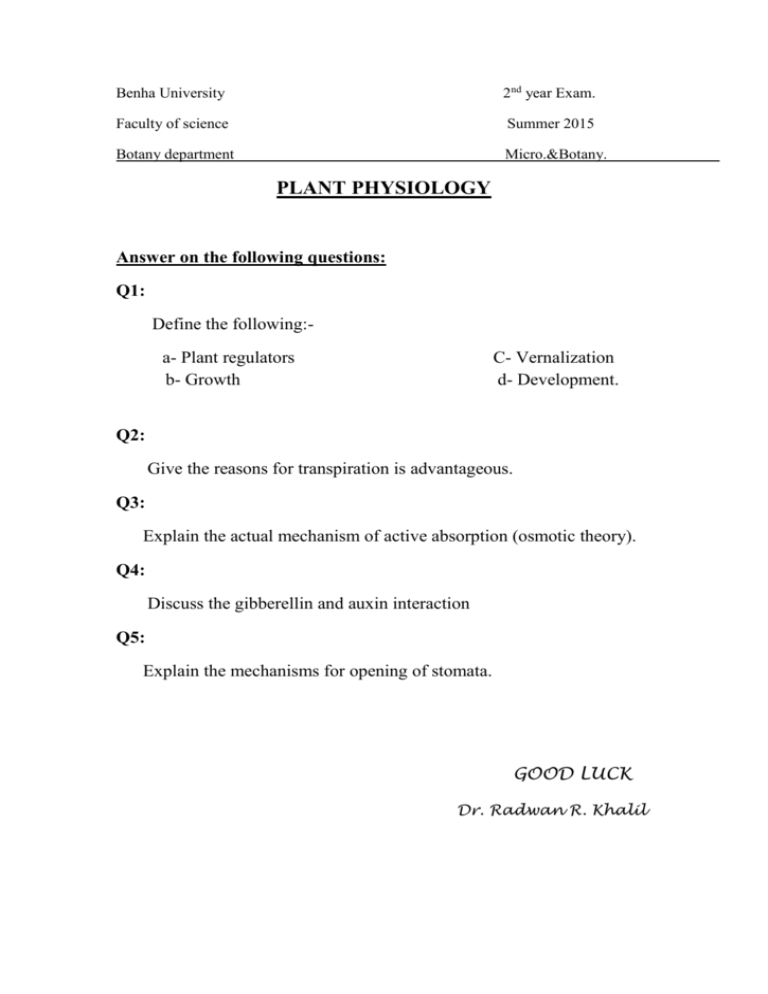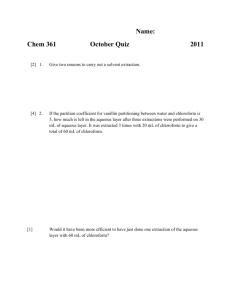Benha University 2nd year Exam. Faculty of science Summer 2015
advertisement

Benha University 2nd year Exam. Faculty of science Summer 2015 Botany department Micro.&Botany. PLANT PHYSIOLOGY Answer on the following questions: Q1: Define the following:a- Plant regulators b- Growth C- Vernalization d- Development. Q2: Give the reasons for transpiration is advantageous. Q3: Explain the actual mechanism of active absorption (osmotic theory). Q4: Discuss the gibberellin and auxin interaction Q5: Explain the mechanisms for opening of stomata. GOOD LUCK Dr. Radwan R. Khalil Answer the Exam. Q1: Plant regulators:They are organic compounds other than nutrients that in small amounts promote, inhibit, or otherwise modify a physiological process in plants. Growth:An increase in size and is concerned with the increasing amount of the organism. Vernalization:The relation of temperature to flowering may be due to either the direct effects of temperature under which the plant is grown or due to the after effects of temperature treatment. Development:The change in shape, form, degree of differentiation and state of complexity. Q2: Give the reasons for transpiration is advantageous. 1- it creates suction force and help in the ascent of sap. 2- it affects the diffusion pressure deficit, there by indirectly helping diffusion through the cells. 3- it affects the absorption of water and minerals by root. 4- it helps in evaporating excess amount of water. 5- it is supposed that it plays a necessary role in translocation of food from one portion of the plant to the other. 6- it maintains the suitable temperature of leaves. 7- it brings about the opening and closing of stomata which indirectly influences the process of photosynthesis and respiration. 8- effect on growth and development. Q3: Explain the actual mechanism of active absorption (osmotic theory). The mechanism of absorption of water is of two types: active and passive often operating independently. In active mechanism, water is absorbed by the force developing in the root system. Active absorption generally takes place in slowly transpiring and wellwatered plants. In passive absorption mechanism, the forces responsible for the absorption of water develop in the shoot system, which are ultimately transmitted to the root system. The roots play a passive role in this mechanism. Passive absorption is, generally found in rapidly transpiring and ill-watered plants. Active absorption of water: Two types of theories such as osmotic theory and non Osmotic theory have been proposed to explain active absorption of water by plants. (i)Osmotic Theory: The somatic theory explains that the root hairs act as ohmmeters and there exists a typical condition so that water can move across osmotic ally from the soil solution to the root xylem. The theory assumes that translocation of water takes place by means of diffusion along a gradient of decreasing water potential or increasing solute potential. Absorption of water means translocation of water from soil solution to the xylem of root. The xylem sap, according to this theory, possesses a higher osmotic potentiality thin that of soil solution. So water moves from the soil to the root xylem by cells to cell osmosis. Because osmosis is a function of living cell, this process of osmotic water absorption is included under active process. Q4: Discuss the gibberellin and auxin interaction Response activity Auxins Gibberellin s 1-apical dominance promote No effect 2-avena coleoptile elongation promote No effect 3-bolting and flowering No effect promote 4-growth of dwarf pea stem sections promote No effect 5-leaf abscission promote No effect 6-parthenocarpic promote Promote 7-polar transport Yes(stems) no effect (roots) No effect 8-root initiation promote No effect 9-root growth promote No effect 10-seed germination No effect promote Q5: Explain the mechanisms for opening of stomata. light Respiration occure very little co2 in guard Co2 in guard cells decreased Malic acid produced cell photophospherylation ATP formed Organic acid decreased pH of guard cells raised to 7.0 Phosphorylation activated Starch hydrolysis ATP formed ATP drived proton and k pump H out of and k into guard cells K ,Cl increased in guard cell Water potential more negative in guard cell Water inters guard cells by osmosis Soluble sugar increased Turgor pressure increased Sugar level may be insufficient to affect water potential Stomata opens






